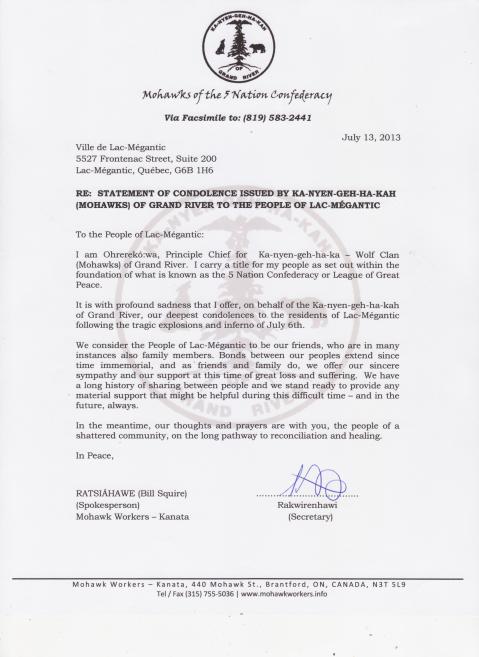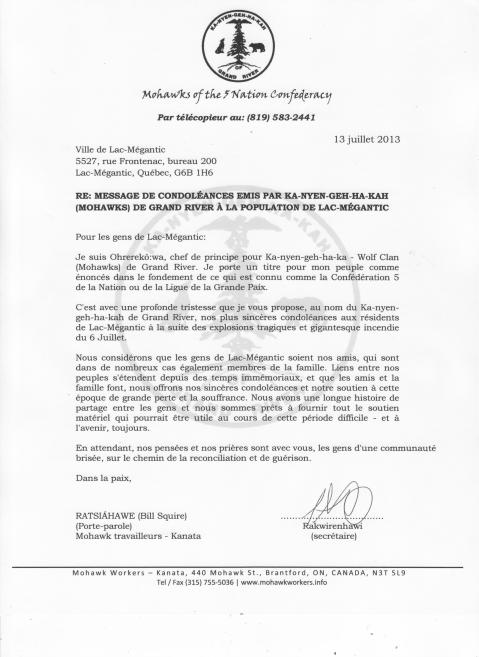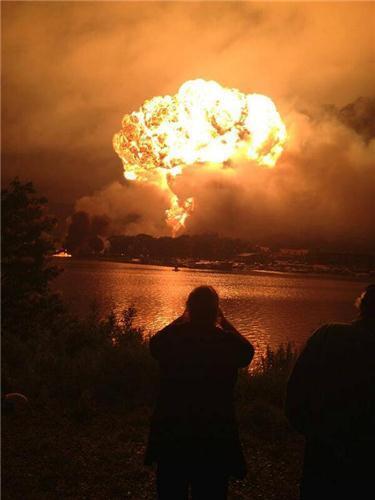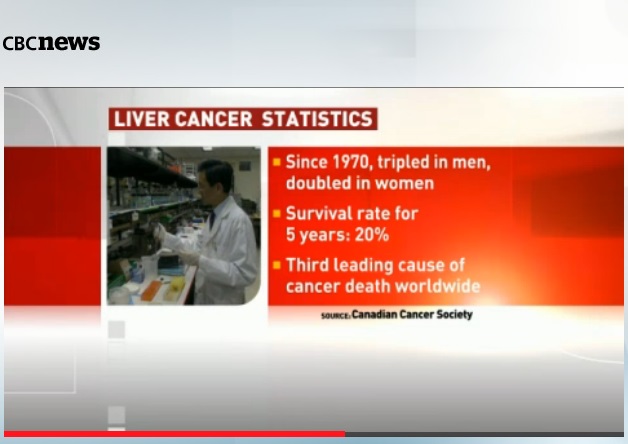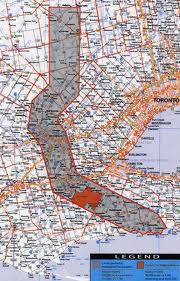HIGH-RISK? Financing Canada’s largest solar power project on Mohawk (Grand River) lands under claim without free, prior & informed consent of principle Chief – Mohawk Wolf Clan – in face of stated objections to all relevant parties – which remain ignored
Dear Barry Critchley (and to Whom Else It May Concern):
I work in support of Ohrerekó:wa, the principle Chief of the Mohawk Wolf Clan of Tkanatáhere (Grand River). I am surprised to learn about the magnitude of what appears to me to be “high risk” financing in respect of the Samsung venture you reported upon on October 22nd.
[http://business.financialpost.com/2013/10/22/financing-canadas-largest-solar-power-project/].
My best guess is that not all relevant parties have been fully informed – and in fact may have been misled. It appears clear to me that at the very least, the public is only being told part of the truth, and accordingly, I would like to provide you with some additional background, context and facts in order that a clearer picture of this fiasco may be reported upon, and appropriately dealt with – bearing all facts in mind. I note that investors and stakeholders who may well be unaware of the totality of relevant circumstances ought to somehow enlightened.
It also appears to me that neither Samsung entities and affiliates, the county of Haldimand, province of Ontario, nor indeed the federal government is saying much about the fact that without the free, prior and informed consent – of ALL relevant parties (such as Ohrerekó:wa who represents the Mohawk Wolf Clan), this venture, which is proposed to take place upon claimed Mohawk lands (See: Haldimand’s proclamation of 1784), may well be deemed to be unlawful given that the actions of the parties involved appear inconsistent with the United Nations Declaration on the Rights of Indigenous Peoples. I can advise that Ohrerekó:wa remains committed and poised to seeing that his objections are addressed and that his people’s land be protected from further unauthorized plunder and exploitation. I can further advise that Ohrerekó:wa January 2013 appeal to the Queen (which was acknowledged by Buckingham palace on February 13th, 2013), remains outstanding, and is in the process of being address by the Governor General of Canada, the Premier of Ontario, and relevant Ministers of indigenous affairs at both the federal and provincial levels. (NOTE: Ohrerekó:wa has been acknowledged by the Crown as the principle chief of the Mohawk Wolf Clan since his appointment in 1972, as evidenced by the attached Confirmation Notice dated November 27, 1972, and as recently as May 13, 2013 in written correspondence issued by the Imperial Crown).
It is our position that the “Six Nations’ Elected Band Council” (including the chief councilor, Bill Montour, who with a mere 332 of nearly 21,000 eligible votes, was just ousted in Saturday’s election) can not in any way be seen to represent the people who have a bona fide claim to the lands in question by birthright.
In fact, only 5% of the eligible ‘voters’ even took part in last week’s sham elections of Indian Act band councilors, presumably because voting in Canada’s band council system is illegal under the Rotinonshonni ónhwe’s (Mohawk) constitution of the League of Great Peace. I contend that 95% of the eligible voting population is not represented by those who appear to have agreed to – and also appear to expect to profit from – this venture, namely the de facto elected band council which was imposed by force by the government of Canada in 1924 and clearly remains boycotted as a sham to this day.
The law of these lands states that those who submit to foreign laws / jurisdiction such as the “Indian Act” forfeit all birthrights and claims under the Great Law. According to the Rotinonshonni ónhwe:
If, at any time, anyone of the chiefs of the League choose to submit to the law of a foreign people, he is no longer in but out of the League and persons of this class shall be called, “They have alienated themselves” (Tehonatonkoton). Likewise, such persons who submit to laws of foreign nations shall forfeit all birthrights and claims of the League of Five Nations and territory. [Kayaneren`tshera ko:wa, Wampum of the 58th part].
Both Samsung, and the elected band council, as well as the Mayor of Haldimand County, Ken Hewitt, have each been repeatedly warned by the Mohawks about pursuing this venture without complying with the law (see attached 2013 June 26 Letter to Korean Embassy RE Samsung-Six Nations Alert), in the face of Ohrerekó:wa objections. These issues have been raised by Ohrerekó:wa’s office to his ally, Queen Elizabeth II, the Special Rapporteur on the Rights of Indigenous Peoples, James Anaya (see: 2013 May 11 Letter to Jason Bowman from Special Rapportuer RE May 20 Meeting in NY to Discuss Complaint, 2013 May 20 Letter RE Meeting with James Anaya – Special Rapporteur on the rights of indigenous peoples, and 2013 May 20 – UNDRIP chart with links – Articles 1-10), as well as opposition members of parliament and foreign diplomats alike. I find it both startling, and hard to believe, that notwithstanding these well-founded and publicly-stated objections – and moreover, in lieu of free, prior and informed consent of the affected peoples – that any party would consider financing such an evidently risky and oppressive venture, given the myriad of substantial liability issues which can arise and ensue.
I have attached some background reference materials for your information, and am happy to forward further details upon request – or to facilitate interviews as requested.
Sincerely,
Jason Bowman (Special Assistant to the Ka-nyen-geh-ha-kah of Grand River and Office of Ohrerekó:wa, Principle Chief – Mohawk Wolf Clan)
Copies to: Mayor of Haldimand County Ken Hewitt, Ambassador to Canada for the Republic of Korea Cho Hee-yong, Six Nations Chief Elected Councilor William K. Montour, Samsung Electronics Co. CEO Dr. Oh-Hyun Kwon, Samsung CSLT CEO Sin Kim, CC&L President & CEO Matt O’Brien, Counsel for RBC Emily Jelich, Manager of government and public relations for Samsung Renewable Energy Timothy Smitheman, Media Relations for Pattern Energy Matt Dallas, Minister of Energy for Ontario Bob Chiarelli, MPP, Minister of Aboriginal Affairs for Ontario David Zimmer, MPP, Investor Relations – Pattern Energy Group Inc. Ross Marshall, Complaints – Ontario Securities Exchange
CC: Jim Windle (Two Row Times), Josh Blakeney (PressTV), David Langer (Two Row Times), Dr. James Anaya (Special Rapporteur on the Rights of Indigenous Peoples – United Nations Office of the High Commissioner for Human Rights), Geoffrey West (CVN), Terrance Nelson (Vice-chair – American Indian Movement), Jean Crowder, MP (Official Opposition Critic for Aboriginal Affairs), Dr. Anthony Hall (Professor of Globalization Studies, University of Lethbridge and author of Earth into Property), Dr. Carolyn Bennett, Aboriginal Affairs Critic & Chair of Women’s Caucus – Liberal Party of Canada), Kirk Falconer (Thomson Reuters)
[See more at: http://ontario-wind-resistance.org/2012/06/16/approved-samsung-grand-renewable-148-6mw-project/] 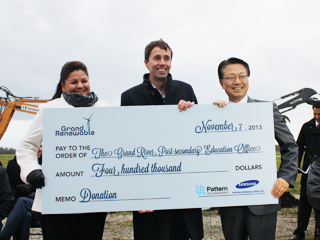
“The partners involved are Haldimand County, Samsung Renewable Energy Inc., Pattern Energy Group LP and the Six Nations of the Grand River. Siemens Canada turbine blade facility in Tilsonburg is manufacturing blades for the project, and CS Wind’s facility in Windsor is using Ontario-made steel to manufacture the turbine towers.”
United Nations Declaration on the Rights of Indigenous Peoples
Article 26
1. Indigenous peoples have the right to the lands, territories and resources which they have traditionally owned, occupied or otherwise used or acquired.
2. Indigenous peoples have the right to own, use, develop and control the lands, territories and resources that they possess by reason of traditional ownership or other traditional occupation or use, as well as those which they have otherwise acquired.
3. States shall give legal recognition and protection to these lands, territories and resources. Such recognition shall be conducted with due respect to the customs, traditions and land tenure systems of the indigenous peoples concerned.
Article 27
States shall establish and implement, in conjunction with indigenous peoples concerned, a fair, independent, impartial, open and transparent process, giving due recognition to indigenous peoples’ laws, traditions, customs and land tenure systems, to recognize and adjudicate the rights of indigenous peoples pertaining to their lands, territories and resources, including those which were traditionally owned or otherwise occupied or used. Indigenous peoples shall have the right to participate in this process.
Article 37
1. Indigenous peoples have the right to the recognition, observance and enforcement of treaties, agreements and other constructive arrangements concluded with States or their successors and to have States honour and respect such treaties, agreements and other constructive arrangements.
2. Nothing in this Declaration may be interpreted as diminishing or eliminating the rights of indigenous peoples contained in treaties, agreements and other constructive arrangements.
What is free, prior and informed consent?
To hear more programs and download them as mp3s, click here.
According to the UN Declaration on the Rights of Indigenous Peoples, Indigenous communities have the right to give their Free, Prior and Informed Consent (FPIC) to proposed projects that may affect their lands, resources, livelihoods, and communities. This means that Indigenous communities have the right to decide whether they want companies or governments to mine, deforest, or in other ways develop their lands, and they have the right to make informed decisions through culturally relevant processes.
The element of “free” implies no coercion, intimidation or manipulation; “prior” implies that consent is obtained in advance of the activity associated with the decision being made, and includes the time necessary to allow indigenous peoples to undertake their own decision-making processes; “informed” implies that indigenous peoples have been provided all information relating to the activity and that that information is objective, accurate and presented in a manner and form understandable to indigenous peoples; “consent” implies that indigenous peoples have agreed to the activity that is the subject of the relevant decision, which may also be subject to conditions.”
Siemens Canada:
Corporate Lobby Team
What is being lobbied?
Aboriginal Affairs
Defence
Energy
Environment
Government Procurement
Health
Industry
Infrastructure
International Trade
Mining
Regional Development
Research and Development
Science and Technology
Telecommunications
Transportation
Subject Matter Details / Policies or Program
Discuss Canadian Manufacturers & Exporters’ trade policy priorities.
Discuss with government officials regarding Western Economic
Diversification Canada’s role in Industrial and Regional Benefits (IRBs) for shipbuilding and resource development including pipelines.
Discussion with government officials regarding public policy options relating to the application of information technology to improve efficiencies of energy systems, fire safety and security systems.
Discussions with Goverment officials regarding Scientific Research and Experimental Development (SR&ED) program and suggestions relating to development of a manufacturing and exporting strategy for Canada.
Discussions with government officials regarding clean water programs, both generally and in relation to aboriginal communities specifically including clean water strategies, initiatives, policies and programs.
Discussions with government officials regarding new policies or programs to increase government spending for transportation/transit.
Health infrastructure – Discuss with Canada national health infrastructure program with relation to modernization, e-health, and patient records.
Manufacturing and exporting action plan for Canada
Discussions with government officials with respect to health care equipment standards
Who is being lobbied?
Government Institutions
Aboriginal Affairs and Northern Development Canada (AANDC)
Atlantic Canada Opportunities Agency (ACOA)
Canada Revenue Agency (CRA)
Canadian Transportation Agency (CTA)
Correctional Service of Canada (CSC)
Employment and Social Development Canada (ESDC)
Environment Canada (EC)
Federal Economic Development Agency for Southern Ontario (FedDev)
Federal Office of Regional Development – Quebec (FORD[Q])
Finance Canada (FIN)
Fisheries and Oceans Canada (DFO)
Foreign Affairs, Trade and Development Canada (DFATD)
Health Canada (HC)
House of Commons
Industry Canada (IC)
Members of the House of Commons
National Defence (DND)
Prime Minister’s Office (PMO)
Public Safety and Emergency Preparedness Canada (PSEPC)
Public Works and Government Services Canada (PWGSC)
Royal Canadian Mounted Police (RCMP)
Transport Canada (TC)
Treasury Board Of Canada Secretariat (TBS)
Western Economic Diversification Canada (WD)
Who are the lobbyists?
Robert Hardt, President and Chief Executive Officer
Rob Aiello, Regional Manager
Jose Froylan Aparicio, Branch Operation Manager
Richard Brait, Secretary and General Counsel
Carol Buckton, Senior Director, Trade Logistics
Ken Isnor, Project Manager
Robert Keen, General Manager
Donna Mercer, Vice President, Divisional Controller IA/DT
Jacques Milette, Sales Manager, Eastern Canada
Joris Myny, Vice President, Industry Automation and Drives
James Graziadei, Sr. VP Healthcare Sector
Michael Gross, Senior Vice President, Industry Sector Controller
Daniel Groulx, Regional Manager
Richard Hansen, Manager, Aboriginal Affairs
Public offices held:
| National Director Advocacy and Partnerships Directorate Indian and Northern Affairs Canada, Socio- Economic Policy and Programs Sector, Economic Development Branch |
March 2003 to 2007 | |
| National Director Aboriginal Workforce Participation Initiative Directorate, Indian and Northern Affairs Canada, Socio- Economic Policy and Programs Sector, Economic Development Branch |
March 2001 to February 2003 | |
| National Career Councellor Indian and Northern Affairs Canada, Corporate Services Sector,, Human Resources Branch,Leadership and Developement Directorate |
January 2000 to February 2001 |
Rocco Delvecchio, Vice President, Government Affairs
Public offices held:
| Consul General in Detroit (United States of America) Department of Foreign Affairs and International Trade, Consulate |
August 2002 to February 2006 | |
| Executive Director of Investment Partnerships Canada Industry Canada and the Department of Foreign Affairs and International Trade, Investment Partnerships Canada |
1996 to 2002 | |
| Director General and Manager, Forest Industries and Building Products, and Functional Adviser for Trade Industry Canada, Forest Industries and Building Products |
1995 to 1996 |
UNSR James Anaya: Statement upon conclusion of the visit to Canada

United Nations Special Rapporteur on the rights of indigenous peoples, James Anaya Statement upon conclusion of the visit to Canada 15 October 2013 I am now concluding my visit to Canada in my capacity as United Nations Special Rapporteur on the rights of indigenous peoples. Over the last nine days I have met with federal and provincial government authorities, and with First Nations, Inuit, and Métis leaders, organizations and individuals in several parts of the country. In addition to being in Ottawa, my meetings have taken me to various places, including indigenous territories, in British Columbia, Alberta, Saskatchewan, Manitoba, Ontario, and Québec. I am grateful to the Government of Canada for its cooperation and for the information it has provided, and for allowing me to carry out my visit freely and in an independent manner. I would also like to express my deep gratitude to representatives of indigenous peoples who invited me to visit their territories and communities across Canada, and to those indigenous organizations and individuals who assisted me in organizing parts of my agenda. Finally, I especially want to thank the indigenous peoples with whom I met for sharing with me their stories, concerns and aspirations. I am honored to have been welcomed into their communities and territories, and am truly humbled by their hospitality and warmth. Over the past several days, I have collected a significant amount of information from indigenous peoples and Government representatives across the country. In the following weeks, I will be reviewing the extensive information I have received during the visit in order to develop a report to evaluate the situation of indigenous peoples in Canada and to make a series of recommendations. This report will be made public, and will be presented to the United Nations Human Rights Council. I hope that that this report will be of use to First Nations, Inuit, and Métis people, as well as to the Government of Canada, to help find solutions to ongoing challenges that indigenous, or aboriginal, peoples in the country face. In advance of this report, I would like to now provide some preliminary observations and recommendations on the basis of what I have observed during my visit. These do not reflect the full range of issues that were brought to my attention, nor do they reflect all of the initiatives on the part of federal and provincial governments related to indigenous issues. Canada, with its diverse and multicultural society, has been a leader on the world stage in the promotion of human rights since the creation of the United Nations in 1945. And it was one of the first countries in the modern era to extend constitutional protection to indigenous peoples’ rights. This constitutional protection has provided a strong foundation for advancing indigenous peoples’ rights over the last 30 years, especially through the courts. Federal and provincial governments have made notable efforts to address treaty and aboriginal claims, and to improve the social and economic well being of indigenous peoples. Canada has also addressed some of the concerns that were raised by my predecessor following his visit in 2003. These include actions to remedy gender disparities in the Indian Act and to providing access to the Canadian Human Rights Commission for claims based on the Indian Act. Additionally, Canada has adopted the goal of reconciliation, to repair the legacy of past injustices, and has taken steps toward that goal. But despite positive steps, daunting challenges remain. From all I have learned, I can only conclude that Canada faces a crisis when it comes to the situation of indigenous peoples of the country. The well-being gap between aboriginal and non-aboriginal people in Canada has not narrowed over the last several years, treaty and aboriginals claims remain persistently unresolved, and overall there appear to be high levels of distrust among aboriginal peoples toward government at both the federal and provincial levels. Canada consistently ranks near the top among countries with respect to human development standards, and yet amidst this wealth and prosperity, aboriginal people live in conditions akin to those in countries that rank much lower and in which poverty abounds. At least one in five aboriginal Canadians live in homes in need of serious repair, which are often also overcrowded and contaminated with mould. The suicide rate among Inuit and First Nations youth on reserve, at more than five times greater than other Canadians, is alarming. One community I visited has suffered a suicide every six weeks since the start of this year. Aboriginal women are eight times more likely to be murdered than non-indigenous women and indigenous peoples face disproportionately high incarceration rates. For over a decade, the Auditor General has repeatedly highlighted significant funding disparities between on-reserve services and those available to other Canadians. The Canadian Human Rights Commission has consistently said that the conditions of aboriginal peoples make for the most serious human rights problem in Canada. It is clear to me that Canada is aware of and concerned about these issues, and that it is taking steps to address them. I have learned about numerous programs, policies and efforts that have been rolled out at the federal and provincial levels, and many of these have achieved notable successes. However, it is equally clear that these steps are insufficient, and have yet to fully respond to aboriginal peoples’ urgent needs, fully protect their aboriginal and treaty rights, or to secure relationships based on mutual trust and common purpose. Aboriginal peoples’ concerns and well-being merit higher priority at all levels and within all branches of Government, and across all departments. Concerted measures, based on mutual understanding and real partnership with aboriginal peoples, through their own representative institutions, are vital to the long-term resolution of these issues. Importantly, Canada has taken action toward the goal of reconciliation between aboriginal and non-aboriginal Canadians with the 2008 government apology for the residential schools and the creation of the Truth and Reconciliation Commission. The Truth and Reconciliation Commission has been documenting the horrifying stories of abuse and cultural dislocation of indigenous students who were forced from their homes into schools whose explicit purpose was to destroy their family and community bonds, their language, their culture, and their dignity, and from which thousands never returned. Generations of aboriginal children grew up in residential schools estranged from their cultures and languages, with devastating effects on maintaining indigenous identity. It is clear that the residential school period continues to cast a long shadow of despair on indigenous communities, and that many of the dire social and economic problems faced by aboriginal peoples are directly linked to that experience. I urge the Government to ensure that the mandate of the Truth and Reconciliation Commission be extended for as long as may be necessary for it to complete its work, and to consider establishing means of reconciliation and redress for survivors of all types of residential schools. In addition, I would like to emphasize that the mark on Canada’s history left by the residential schools is a matter of concern to all of Canada, not just aboriginal peoples, and that lasting healing can only truly occur through building better relationships and understanding between aboriginal peoples and the broader society. Another aspect of the long shadow of residential schools, combined with other historical acts of oppression, is the disturbing phenomenon of aboriginal women missing and murdered at the hands of both aboriginal and non-aboriginal assailants, whose cases have a much higher tendency to remain unresolved than those involving non-aboriginal victims. Certainly, both federal and provincial governments have taken steps targeted at addressing various aspects of this issue. Yet over the past several days, in all of the places I have visited, I have heard from aboriginal peoples a widespread lack of confidence in the effectiveness of those measures. I have heard a consistent call for a national level inquiry into the extent of the problem and appropriate solutions moving forward with the participation of victims’ families and others deeply affected. I concur that a comprehensive and nation-wide inquiry into the issue could help ensure a coordinated response and the opportunity for the loved ones of victims to be heard, and would demonstrate a responsiveness to the concerns raised by the families and communities affected by this epidemic. These and further steps are required to realize the promise of healing and a new relationship that was made in the 2008 apology. Among all the government and aboriginal people with whom I have met, there is agreement that improving educational outcomes for aboriginal people is a key to addressing many of the other problems facing them. I commend the governments at both levels for placing a high priority on education. However, I have heard remarkably consistent and profound distrust toward the First Nations Education Act being developed by the federal government, and in particular deep concerns that the process for developing the Act has not appropriately included nor responded to aboriginal views. In light of this, I urge the Government not to rush forward with this legislation, but to re-initiate discussions with aboriginal leaders to develop a process, and ultimately a bill, that addresses aboriginal concerns and incorporates aboriginal viewpoints on this fundamental issue. An equally important measure for improving educational outcomes, and one that could be implemented relatively quickly, is to ensure that funding delivered to aboriginal authorities for education per student is at least equivalent to that available in the provincial educational systems. As was stressed to me throughout my visit, it will be difficult to improve educational outcomes without addressing the substandard housing conditions in which many aboriginal people live. Young people described to me the difficulty they have studying in small homes overcrowded by generations of family members. Other social problems have also been linked to these overcrowded conditions, including high rates of tuberculosis and other health problems, family violence, unemployment, and unwanted displacement to urban centres. Overcrowding of homes leads to increased wear and tear and the premature deterioration of existing housing stock, resulting in dilapidated and often unsafe housing conditions. It is abundantly clear that funding for aboriginal housing is woefully inadequate. The housing problem has a significant economic and social impact; the Chief of one community I visited indicated that if adequate housing were available, the vast majority of his community’s members with university degrees—nurses, teachers, engineers—would choose to return home. A woman from the same community who more typically had not had the opportunity to attend university, told me that as she became an adult she had no chance of having a house of her own, but rather was forced to remain in her parents home for years to come, with few prospects for developing a life on her own. “It is as if I’m not a person”, she said. I urge the Government to treat the housing situation on First Nations reserves and Inuit communities with the urgency it deserves. It simply cannot be acceptable that these conditions persist in the midst of a country with such great wealth. By all accounts, increased investment in building self-governing capacity is essential to creating socially and economically healthy and self-sufficient aboriginal communities. One hundred and thirty years of Indian Act policies persistently undermined—and in some cases continue to undermine—many First Nations’ and Inuit peoples’ historic self-governance capacity. Enhancing economic development opportunities is also crucial to restoring and building healthy and vibrant aboriginal nations and communities. I acknowledge the many initiatives by Canada to strengthen aboriginal governance and catalyze economic development. And I applaud the many successes a number of aboriginal communities have had in building governance capacity and pursuing economic development opportunities. But at the same time I note the frustration expressed to me uniformly by aboriginal leaders that their self-governance capacity and economic development, and improved conditions more generally, remain impeded by the multiple legacies of the history of colonization, treaty infringements, assault on their cultures, and land dispossession suffered by their peoples. To address these legacies Canada has developed specific and comprehensive claims processes that in many respects are models for the world to emulate. There are noteworthy success stories arising out of these procedures. But in their implementation overall, the claims processes have been extremely slow and mired in challenges—challenges that appear in most cases to stem from the adversarial structure of negotiations, in which entrenched opposing positions often develop on key issues and agreement simply cannot be reached. To make this worse, resource development often proceeds at a rapid pace within lands that are the subject of protracted negotiations between aboriginal peoples and the Government, undermining the very purpose of the negotiations. The Government has rightly acknowledged problems with the claims processes. In 2008, it took action to reform the claims processes, including by imposing a time limit for settlement of specific claims. I commend the Government’s recent efforts to establish high-level oversight committees on treaty and comprehensive claims, which I hope will help to address in a timely fashion many of the concerns shared by both Government and indigenous peoples related to these processes. In this context, in re-thinking the available claims processes, I encourage the Government to take a less adversarial, position-based approach in which it typically seeks the most restrictive interpretation of aboriginal and treaty rights possible. In this regard, the Government should instead acknowledge that the public interest is not opposed to, but rather includes, aboriginal concerns. The goal of reconciliation that has been cited by the Government and indigenous peoples alike requires a more generous and flexible approach that seeks to identify and create common ground. Further, as a general rule, resource extraction should not occur on lands subject to aboriginal claims without adequate consultations with and the free, prior and informed consent of the aboriginal peoples concerned. More generally, greater efforts are needed to improve avenues of communication between Canada and aboriginal peoples to build consensus on the path forward. In all my meetings with aboriginal leaders and community members it was evident that there is a significant level of discontent with the state of relations with federal and provincial authorities, as well as a widely held perception that legislative and other decisions over multiple matters of concern to them are being taken without adequate consultation or consideration of their inherent and treaty rights. I urge the federal Government especially to work with aboriginal peoples, through their representative institutions and authorities, to overcome this condition of mistrust. As with the Education Act initiative mentioned earlier, unless legislative and other government actions that directly affect indigenous peoples’ rights and interests are made with their meaningful participation, those actions will lack legitimacy and are likely to be ineffective. In order for the Government to move forward to address the concerns of indigenous peoples in partnership with them, it is necessary to arrive at a common understanding of objectives and goals that are based on full respect for indigenous peoples’ constitutional, treaty, and internationally-recognized rights. Indigenous leaders from First Nations with historical treaties repeatedly expressed to me their yearning for the friendship, respect and sharing of resources that they understand the treaties to embody, and aboriginal leaders look to future arrangements based on similar premises. Such aspirations provide a much stronger grounding for a Canada respectful of human rights than a premise of indigenous subjugation and extinguishment of rights. In addition to historical treaties and constitutional principles, the international standards endorsed by Canada and aboriginal peoples, in particular the United Nations Declaration on the Rights of Indigenous Peoples, should inform the definition of common objectives and goals. Canada’s 2010 endorsement of the Declaration marked an important step on the path towards reconciliation with indigenous peoples, and Canada should be commended for joining most all of the rest of the countries of the world in support of this instrument. I was pleased to hear, throughout my visit, references by First Nations, Inuit and Métis people to the Declaration, and about the incorporation of its standards into their work. It is my hope that the provincial and federal governments in Canada, as well as the country’s courts, will aspire to implement the standards articulated by the Declaration. The Declaration can help to provide a common framework within which the problems that I have outlined here in a preliminary fashion can be addressed. I look forward to developing more detailed observations and recommendations beyond these initial comments in my report to the Human Rights Council. My observations and recommendations will be aimed at identifying good practices and needed reforms in line with the Declaration on the Rights of Indigenous Peoples and other international instruments that mark Canada’s international human rights obligations. I hope that this process will contribute to ensuring that the indigenous peoples of Canada can continue to thrive and maintain their distinct ways of life as they have done for generations despite the long shadow of a history of misdealing, enriching Canadian society for the benefit of all. * * * |
UN Rep starts tour of Canada in Akwesasne
APTN National News Feature | 08. OCT, 2013 By: MARK BLACKBURN
VIDEO:
http://aptn.ca/pages/news/2013/10/08/un-rep-starts-tour-of-canada-in-akwesasne/
Learn more about the visit. http://unsr.jamesanaya.org/
UN experts highlight pressing issues ahead of the first indigenous peoples’ world conference
From: http://www.ohchr.org 3 October 2013
“The adoption of the [UN Declaration on the Rights of Indigenous Peoples] marked a historical moment of recognition of the existence of indigenous peoples who are characterized by distinct cultural identities, and who have suffered and in many ways continue to suffer, widespread and systematic deprivation of their human rights,” said James Anaya, UN expert on indigenous peoples rights.
 The Declaration set the international standards for the promotion and protection of indigenous peoples’ rights. Anaya, who was appointed a year after the Declaration’s adoption in 2007, said he had witnessed indigenous peoples striving to realize the Declaration’s vision amid daunting challenges, among which were threats to lands and resources by extractive companies, as detailed in his reports.
The Declaration set the international standards for the promotion and protection of indigenous peoples’ rights. Anaya, who was appointed a year after the Declaration’s adoption in 2007, said he had witnessed indigenous peoples striving to realize the Declaration’s vision amid daunting challenges, among which were threats to lands and resources by extractive companies, as detailed in his reports.
Chief Wilton Littlechild, Chairperson Rapporteur of the Expert Mechanism on the Rights of Indigenous Peoples, noted that the latest study conducted by the body outlined the issues, challenges and barriers linked to indigenous peoples’ access to justice in truth and reconciliation processes and other contexts, including for women, children, youth and persons with disabilities.
“The Study also notes that indigenous peoples have faced considerable challenges in obtaining national and international respect for their right to self-determination due to State fears that recognition could undermine State authority,” Littlechild said.
“One remedy to this is to reference jurisprudence that recognizes the collective legal personality of indigenous peoples and their communities.” [More]
Chief Sock Serves Eviction Notice to SWN
Also DEVELOPING:
14 Caribbean nations sue European countries for slavery reparations
Lawsuits seek reparations from Britain, France, Netherlands for their roles in Atlantic slave trade
According to Martyn Day, a lawyer from the firm, the first step will be to seek a negotiated settlement with the governments of France, Britain and the Netherlands along the lines of the British agreement in June to issue a statement of regret and award compensation of about $21.5 million to the surviving Kenyans.
“I think they would undoubtedly want to try and see if this can be resolved amicably,” Day said of the Caribbean countries, speaking to The Associated Press in July. “But I think the reason they have hired us is that they want to show that they mean business.”
Caribbean countries Jamaica, Antigua and Barbuda already have national commissions on reparations, and each country that does not have a commission has agreed to set one up. The 14 Caricom nations voted unanimously to wage the joint campaign, saying it would be more ambitious than any previous attempt.
In the United States, the idea of reparations has surfaced and disappeared numerous times.
After the end of the Civil War, about 400,000 acres of land along the Florida, Georgia and South Carolina coasts was taken from former slave owners and set aside for freed slaves, who would each be granted a 40-acre plot of land to farm and make a living. It was the first attempt in the U.S. at reparations, and was reversed by President Andrew Johnson after President Abraham Lincoln was assassinated in 1865.
Most recently in 2008, then-candidate Barack Obama said he did not support reparations for the descendants of slaves, which put him at odds with the NAACP, The Urban League, the SCLC and about two dozen members of Congress who sponsored legislation to create a commission on slavery.
The House issued an apology for slavery in July 2008, and the Senate followed suit in 2009, but neither mentioned reparations.
Caribbean officials have not specified a monetary figure for the lawsuits, but Gonsalves and Verene Shepherd, chairwoman of the national reparations commission in Jamaica, both mentioned the fact that Britain at the time of emancipation in 1834 paid 20 million pounds – the equivalent of 200 billion pounds today – to British planters in the Caribbean.
“Our ancestors got nothing,” Shepherd said. “They got their freedom and they were told ‘Go develop yourselves.'”
Learn more about our efforts to document the
history of corporate colonialism here:
Learn About Onkwehon:we Rights through Community Media
“The most important element of Indigenous Peoples’ ability to claim the right of Free, Prior and Informed Consent is to have informed and organized communities.”– UN Permanent Forum on Indigenous Issues Delegate
The principles of Free, Prior and Informed Consent seek to ensure that a given community has the right to grant or withhold consent for proposed projects that might affect their lands, resources, and territories. Development projects seeking to exploit marginalized areas at low costs often do not take into account the considerations of Onkwehon:we who have lived on and protected these lands for countless generations. FPIC’s emphasis on “prior” consent indicates that Onkwehon:we should be involved in the early planning stages on any development project and before any decisions take place, thus bolstering the opportunity for Onkwehon:we communities to have a voice in how the development process takes its form. The principles of FPIC are enshrined in the UN Declaration on the Rights of Indigenous Peoples and the International Labor Organization (ILO) Convention 169.
The programs were premiered to a listener audience in May 2013 as part of the United Nations Permanent Forum on Indigenous Peoples Issues in New York City. One listener, identified as an Indigenous woman from West Papua, congratulated Cultural Survival on creating the series and spoke to the importance of bringing the concept of ‘Free, Prior and Informed Consent’ into the terms of her own people. “This is something that is part of our culture, something we have always known. You can’t just walk into someone else’s garden and build something.”
To bring home the idea on the local, rural level, Cultural Survival seeks to translate these programs into as many Onkwehon:we languages as possible, with plans already in motion to record in Navajo, Hopi, Hawaiian, and at least six Mayan languages in Guatemala. The initial 20 programs are already available for download in English and Spanish.
The programs’ target audience is Indigenous Peoples in rural communities globally, via a growing network of community radio stations in over 25 countries.
Community radio is an excellent tool for spreading this message, explains Rosy Gonzalez, a Kakchiquel Maya of Guatemala and the Spanish-language producer of the series.
“Because community radio stations broadcast in rural areas, in native languages, they reach an audience that is being directly affected by development projects taking place without their consent. These programs will reach people who are living this problem and are interested in a solution.”
This first series, made possible by a generous grant from the Christensen Foundation, consisted of: ten 30-second public service announcements; ten 60-second short programs; six 3-minute interviews; and two 10-minute features including interviews and analysis. Cultural Survival welcomes comments and feedback and any who are interested in collaborating on these programs to reach our producers via email at consent@cs.org.
“It is important to spread the word among Indigenous communities about the international instruments available for mobilization in struggles for their sovereignty and self-determination. Cultural Survival’s radio programs concentrate on the principles of FPIC in order to make that knowledge free and accessible to Indigenous communities worldwide. While questions remain concerning the determinations made as to who might be affected by a particular development project, what it means to gain recognition as an Indigenous community, and to what member(s) within a community will serve as interlocutors to state and corporate interests, it is important to begin the dissemination of information and grant access to international rights for people calling on governments to respect, protect, and fulfill their obligations under international law,” says Mark Camp, Cultural Survival Deputy Executive Director.
Cultural Survival
Safe Communities
Development Project
UN Declaration, Article 10
Hold Companies Accountable
An Inalienable Right
Also, Yotinonhsonni onhwe (The people who belong to the Original Family & who work to ensure traditional peace – Gayanere:kowa – endures) of Grand (River) Valley at Brant’s Ford – have commenced a weekly internet radio call-in show broadcast to the four corners.
Terrance Nelson: Warrior Societies are Prepared
From: Censored News: Sunday, July 7, 2013 – By Terrance Nelson – Roseau River Anishinabe
To: Jason Bowman
(Special Assistant) Ka-nyen-geh-ha-kah of Grand RiverJason,
Thanks for your email.
Back in 1990 after the “Oka” Crisis, Mark Maracle and other Mohawks met with us in Roseau River to discuss how we reacted to the crisis. We agreed that we were not as organized as we needed to be, that Warrior Societies needed to be more prepared for the eventual conflict with government.
Conservatives in 1990 under Brian Mulroney had no respect for our people and Harper is much the same way. The difference is in how prepared we as Warrior Societies are twenty-three years later.
The Treaty 1-11 meeting in Onion Lake, Saskatchewan July 14 to 18 will be a chance for the people themselves to plan and carry out action to meet the current crisis in Canada. AFN will have their own meeting the same time. There is a break taking place between AFN and those First Nations that are tired of AFN. Only the Chiefs are allowed to speak at AFN summits.
I told Mark that the biggest event in the 1990 Oka Crisis was the railway blockades that took place in Ontario. Two First Nations blocked railway lines. This was the biggest economic impact of the Oka Crisis. Mulroney gave the people in the Treatment Center 48 hours to surrender or he would send in the Army and take them out regardless of the lives that might be lost. We in Manitoba reacted to the Mulroney threat. I stood up on the legislative grounds steps and announced that if Mohawks were killed, we would target Ford, GM, Chrysler, Alcan and of course we were talking blockades of railway lines. The Canadian army was setting up to kill our people. Of course, we would have reacted, but the trouble is that we were severely unprepared in 1990. Today, we are much better prepared.
Treaty 1-11 is not government funded but AFN is and AFN has always been used by Government to keep our people in line. Watch AFN come out from their summit with messages of caution and calls for calm. Watch Government offer appeasements of cash to the Chiefs. The time for the people to have a say in this is now and Onion Lake maybe the place to do that. We will see.
The Train Derailment is being hushed up. It is not front page news because as Douglas Bland warned, the railway lines cannot be protected and the oil pipelines are all in Treaty 1-11 territories.
Thanks again for your continued efforts to keep people informed.
Terrance Nelson
_________________________________________________
“This is an enormous area, 30 buildings just completely destroyed, for all intents and purposes incinerated. There isn’t a family that is not affected by this.” – PM Harper
Learn about PM Harper’s visit to the affected area on Sunday 7/7/2013, where he stated that an “unbelievable disaster” had befallen Lac-Megantic, which is around 250km (155 miles) east of Montreal. He was referring to Saturday’s pre-dawn explosion when runaway crude tankers sent fireballs and black smoke into the air, killing many, and forcing the evacuation of 2,000 people as the area became instantly polluted.
We understand that according to the corporation responsible, the Montreal, Maine & Atlantic train had been parked in the village of Nantes – about 7km (4 miles) from Lac-Megantic – during an overnight driver shift-change. However, its 73 cars carrying pressurized crude oil tankers somehow became uncoupled from five locomotive engines, gathering speed as they rolled downhill before derailing in the heart of the town of Lac-Megantic.
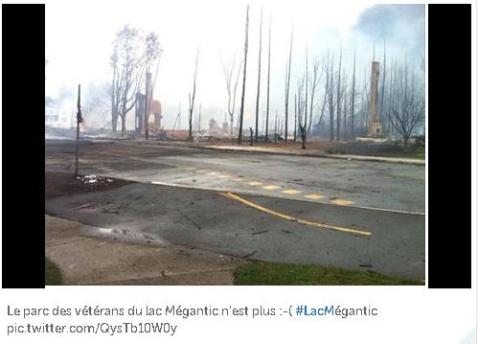
Bernard Demers, who runs a restaurant near the blast site, said the fireball that followed the derailment at around 01:00 (05:00 GMT) on Saturday was:”like an atomic bomb”, the Sunday Telegraph reported.
The train had been travelling from the Bakken Field in North Dakota to a refinery in Saint John, New Brunswick. Montreal, Maine & Atlantic owns more than 800km (500 miles) of track serving Maine, Vermont, Quebec and New Brunswick. http://www.bbc.co.uk/news/world-us-canada-23221939
As leaking crude from the Lac-Mégantic disaster continues to affect nearby towns and water systems, growing numbers are demanding to know why trains carry crude and other toxic hazards through populated areas?
We understand that in 1864, a group of businessmen from Bangor obtained a charter from the State of Maine to construct a railroad from Bangor to Moosehead Lake. The first president of the line was Hannibal Hamlin. In 1868, the State of Maine granted 75,000 acres to the company for the construction of the railroad. In 1891, the Bangor and Aroostook Railroad (BAR) was incorporated combining the Bangor and Piscataquis and Bangor and Katahdin Railroads. In 1893, a BAR train operated to Houlton. One year later, the main line reached Caribou and the branch to Fort Fairfield was completed. By 1905, connections were made to Patten, Limestone, Ashland, and Van Buren. Also in that year, the railroad reached to the deep water port of Searsport.
We understand that initially, the pulp and paper industry constituted the primary source of traffic for the BAR. Subsequent major sources of traffic expand beyond forest products to include toxic chemicals and most significant presently, petroleum products such as crude oil. In 1995, Iron Road Railways bought the Bangor & Aroostook. In January 2003, the BAR assets were acquired by Rail World, Inc. and the name was changed to the Montreal, Maine & Atlantic Railway which currently owns 510 route miles of track in Maine, Vermont and Quebec and employs approximately 170 people. The MMA operates about 15 trains daily with a fleet of 26 locomotives. Main-line operations are conducted regularly between Millinocket and Searsport, Maine, and from Brownville Junction, Maine to Montreal, Quebec. Service is also provided between Farnham, Quebec and Newport, Vermont to connect with the Northeastern U.S. Westbound trains to Montreal are pre blocked for Canadian Pacific destinations in the U.S. and Western Canada.
MMA connects with seven Class I, regional and local railroads and provides the shortest, most-direct rail link between Northern Maine, Saint John, New Brunswick and Montreal. In addition, MMA offers access to port facilities on the Atlantic at Saint John, New Brunswick and Searsport, Maine.
We understand that the Prime Minister of Canada visited Lac-Megantic yesterday, and described the “unbelievable disaster” which had befallen the people now living 250km east of Montreal in the Saturday’s pre-dawn runaway MMA crude oil tanker train wreck explosion. The Prime minister’s statements reflect the gravity of this issue:
“This is an enormous area, 30 buildings just completely destroyed, for all intents and purposes incinerated. There isn’t a family that is not affected by this. There’ll be investigations to ascertain what’s occurred and make sure it can’t happen again.”
We understand that the company has admitted that Montreal, Maine & Atlantic-operated train equipment including 73 railcars containing pressurized crude oil from Baaken North Dakota and five locomotive engines had been abandoned stationed in the village of Nantes – about 7km uphill from Lac-Megantic – during an overnight driver shift-change.
The Sunday Telegraph reported that Bernard Demers, who runs a restaurant near the blast site in Lac-Megantic centre-ville, said the fireball that followed the derailment at around 01:00 (05:00 GMT) on Saturday was “like an atomic bomb”.
We understand that earlier, the train had been travelling from the Bakken Field in North Dakota to a refinery in Saint John, New Brunswick, travelling on portions of track operated by Montreal, Maine & Atlantic whose 800+km rail service extends from Maine, to Vermont, to Quebec to New Brunswick.
As oil leaking from a derailed train in Lac-Mégantic, Que., travels downstream, many are asking why dangerous cargo was being routed directly through a populated riverside town centre – and why would 77 railway tankers filled with crude oil be abandoned / unattended and ‘parked’ several miles uphill from this town? It’s hard for anyone to imagine any ‘emergency break’ system which could hold such immense weight from eventually rolling if sitting on a hill.
Elder (80) Lac-Mégantic Resident Claude Bedard described the scenario as “dreadful”, and stated:
“They should never allow trains carrying that much oil to pass through towns – it makes absolutely no sense – and it makes me angry”
About 80 kilometres downriver from the town of Lac-Mégantic is the community of Saint-Georges, a town that draws its drinking water from the same river that passes by the site of the deadly explosions. Since the explosion, the crude oil being carried by the train has leaked into the nearby waterways, travelling downstream to Saint-Georges.

